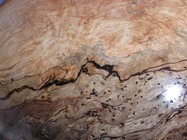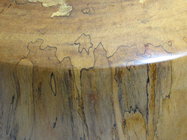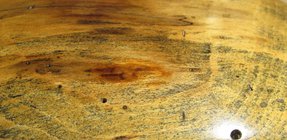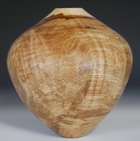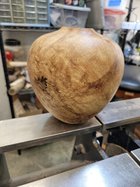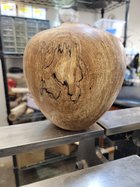"Heavily discolor" is really not definitive enough. We all have our own thoughts with these types of descriptors. If you have some pics of what is too much and what is just right it would help. As far as imparting the least amount of color to the wood, it depends on the look and gloss level desired.
> spray fixative, it seemed next to nothing color wise. It leaves a matte gloss. Long term color shift unknown
> nc lacquer, minimal color on application, several gloss levels available, long term will yellow
> CAB Acrylic lacquer (solvent based) - minimal color on application, several gloss levels available, long term stays clear - that was its design goal
> Parfix 3408 - minimal color on application, hi gloss only, can be rubbed to desired gloss, long term stays clear
> blo - blotches a lot, very yellowing, long dry time, can be rubbed to desired gloss
> poly varnish - blotches a bit less than blo, bit less yellowing vs blo, faster drying. can be rubbed to desired gloss
> Zinsser Sealcoat - blotches some, does cause some coloring. Applied in many thin coats to seal it lessens the coloring
I have had good luck using the CAB Acrylic lacquer as a sealer, hand applied, thinned 1:1, light sanding, poly over the top. It lessens the blotching and coloring. It could probably be hand applied by itself and buffed up, I just haven't tried it. As for oil or poly "muddying" spalted punky wood zone lines, I don't see it, but maybe you can. When applied there is a fuzziness, but after curing and buffing I don't see it.
I took the attached pics today at the same time with the same lighting and camera settings. They were all spalted, punky wood. The 1st is maple with Parfix 3408, the 2nd is sycamore with a bunch of blo and then mw poly, the 3rd is sycamore with mw poly. The poly, alone and with blo, certainly yellowed the wood and created some blotchiness, but to my eye the clarity of the grain and markings is the same.
For smaller pieces, up to ~ 6" x 6" or so, Parfix is a good option. While it is a longer open time CA glue, there are still some limits on how much surface can be covered. Look up Mark Silay on utube if not familiar with it. For any size object, the CAB Acrylic lacquer will work. It depends on the type of finished look you want. For a fully filled glossy finish it needs to be sprayed and I know the sherwin williams stuff I use doesn't come in a spray can. There are probably some water based rattle can products that provide minimal to no coloring but I haven't worked with them. Water based stuff has other limitations that I don't like so I'm not too fond of them.

